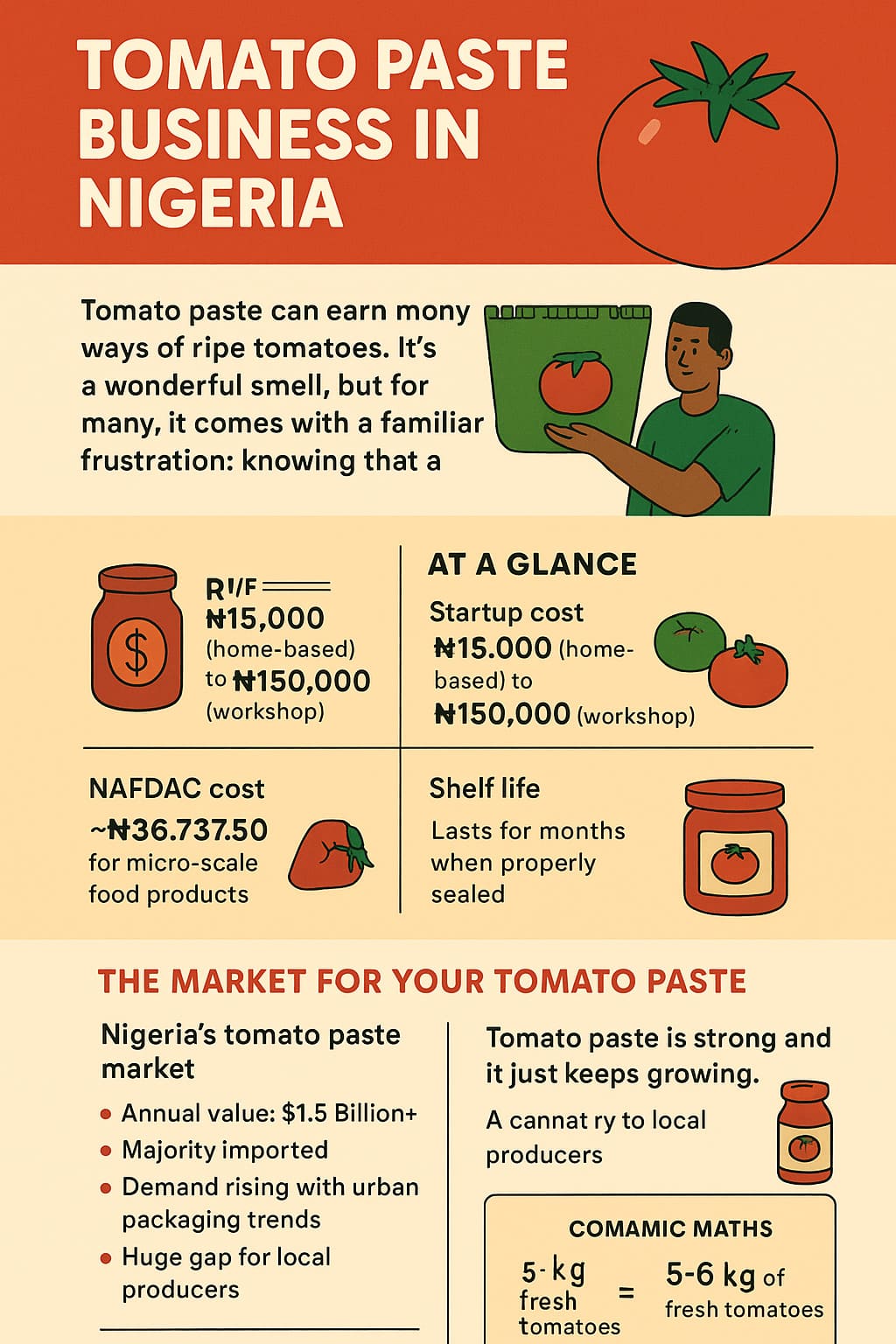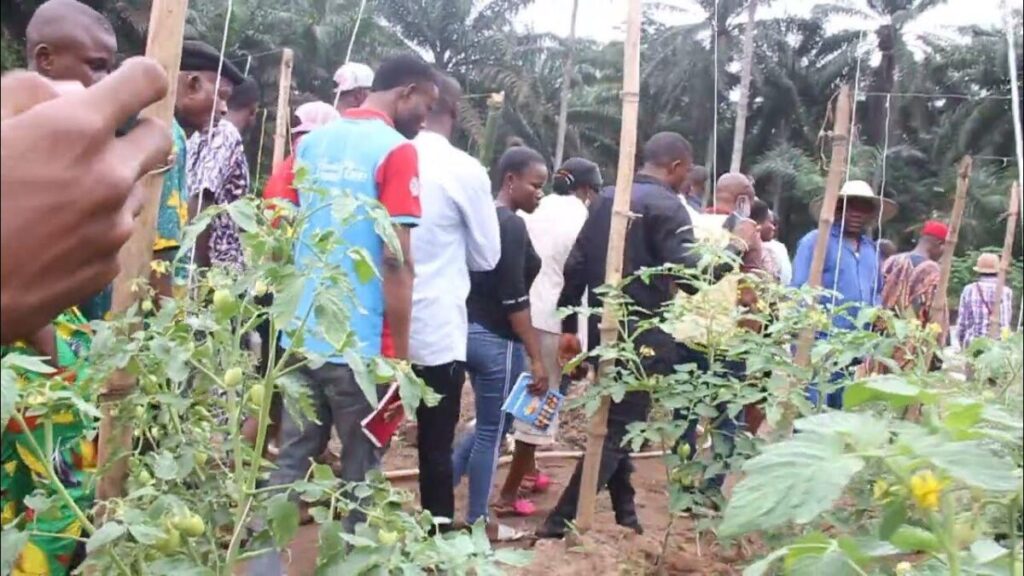Last updated on August 11, 2025
Walk through any Nigerian market and you’ll find the air thick with the sweet, pungent scent of ripe tomatoes. It’s a wonderful smell, but for many, it comes with a familiar frustration: knowing that a huge portion of that harvest will spoil before it ever reaches a kitchen. This problem is your opportunity—the foundation for a profitable, small-scale tomato paste business. As Akin Adesina, President of the African Development Bank, once said, “Agriculture is not a way of life… Agriculture is a business.” This guide helps you treat it exactly like that.
Local production isn’t just about making money; it’s a direct way to fight food waste and create jobs. A study in the Journal of Scientific and Research Reports found that “about 1.8 Million tonnes of fresh tomato are produced per year, but over 50% of these are lost due to poor storage system, poor transportation and lack of processing enterprises.” By starting your own operation, you’re becoming part of the solution to a national challenge. Your journey from farm to airtight jar starts right here.
Table of Content showAt a Glance
- Startup Cost Range: ₦15,000 (home-based) to ₦150,000 (workshop).
- Yield Ratio: ~5–6 kg of fresh tomatoes for every 1 kg of paste.
- NAFDAC Cost: ~₦36,737.50 for micro-scale food products.
- Shelf Life: Lasts for months when properly sealed.
The Market for Your Tomato Paste
Nigeria’s Tomato Paste Market
📦 Annual value: $1.5 Billion+
🛬 Majority imported
📈 Demand rising with urban packaging trends
💼 Huge gap for local producers
The demand for tomato paste in Nigeria is strong and it just keeps growing. It’s a staple in nearly every home, used in stews, jollof rice… you name it. The market is worth over $1.5 billion annually in imports and local production. The crazy thing? A large chunk of that demand is met by imported products. This leaves a significant gap for local producers who can offer high-quality, fresh-tasting paste at a good price.
Urban living is driving a big shift toward packaged food, which is perfect for your business. The economic impact? It’s tangible. Every tin of paste you sell means one less litre of foreign currency leaving our economy. As an article in FurtherAfrica noted about a new processing plant, “this capital will remain within Nigeria, stimulating the local economy, empowering rural communities, and creating thousands of jobs across the whole value chain—from farming and logistics to processing and distribution.”
Sourcing Tomatoes: The Real-Life Challenge
Step one: source quality tomatoes. This can be your biggest headache because of the wild price swings between seasons and regions. So, how much is one kilo of tomatoes in Nigeria? During the peak harvest season (November to February), a 50kg large basket in Kano can cost as little as ₦15,000. But in Lagos during the lean season, that same basket can skyrocket to over ₦100,000. A recent market survey showed a small bucket could jump from ₦6,000 to ₦35,000 in a matter of weeks. For context, 500g of tomatoes — roughly 4–5 medium ones — might cost ₦250–₦500 in peak season, but up to ₦1,000 during lean months in major cities. See what I mean? Planning is everything.
Seasonality Price Gap
Don’t let price fluctuations control your business. You can take proactive steps to secure your supply and lock in favorable prices. Consider entering into a simple contract with a local farmer during the harvest season. By guaranteeing a purchase of a specific volume at an agreed-upon price, you secure your raw materials and give the farmer a stable market.
Bulk-Buy & Store Strategies
Another option is to invest in cold storage, either by building your own or by renting space in a local cold chain facility. This allows you to buy tomatoes in bulk when prices are low and store them until you need them, effectively smoothing out your costs across the year. You could also plan procurement carefully or even grow your own — see our guide on Which Tomato Variety is Best in Nigeria for tips.
Tomato Quantity and Yield at a Glance
This is where the math gets important. Wondering how many tomatoes are in 1kg of paste? It takes roughly 30–35 medium Roma tomatoes, or about 5–6 kg of fresh tomatoes, to make 1kg of thick paste.
| Input | Fresh Tomatoes (Quantity) | Practical Notes | Output (Thick Paste) |
|---|---|---|---|
| 1 kg fresh tomatoes | ~8–10 medium Roma tomatoes | Roma tomatoes are ideal due to their lower water content. | ~160–180g |
| 1 large basket (50kg) | ~400–500 medium tomatoes | This is a typical wholesale quantity. | ~8–9 kg (or 32 cups) |
Quick Maths for a Sample Batch:
- Fresh tomatoes: 100kg (costing ~₦30,000 in harvest season).
- Paste produced: ~16kg.
- Selling at ₦250 per 200g sachet, you pull in about ₦20,000 in revenue per batch during peak demand.
For cooking, you might use 5–6 medium tomatoes to make sauce for 1kg of chicken. But paste is much more concentrated—and versatile. When preparing paste for stew, most Nigerian recipes add onions. One kilo of onions is about 4–6 large bulbs, so you can cost and portion accordingly. By the way, how many tomatoes do you need for 1 cup of puree? Usually about two to three medium tomatoes will do it.

Business Startup Costs: An Example
Getting started can feel daunting, but it’s more manageable than you think. Here’s a simple table to help you visualize the initial investment and potential returns.
| Scale | Batch Size | Startup Cost | Est. Gross Profit |
|---|---|---|---|
| Home-based | 10kg | ₦15,000 | ₦1,800 |
| Workshop | 100kg | ₦150,000 | ₦7,000 |
Turning Tomatoes into Paste: A Step-by-Step Guide
Turning fresh tomatoes into rich paste is a simple, repeatable process. Don’t be intimidated by the fancy equipment—you can start with simple, affordable tools and upgrade as profits roll in.
Starter Equipment:
- Large Cooking Pots
- An Industrial Blender or small pulping machine
- A Fine-mesh Sieve
- Airtight Jars or Sachets
- A Sealing Machine (for sachets)
- A Kitchen Thermometer
Sort & Wash
Right after you buy your tomatoes, get rid of any spoilt or bruised ones. Then, wash them thoroughly to get rid of dirt and chemical residues.
Blanch & Peel
Dip the tomatoes in boiling water for about 30 seconds, then immediately move them to cold water. The skin will practically fall off, which is a must for a smooth paste. This crucial step ensures a smooth paste, and it starts with a healthy crop, as you can see in our guide on the Best Fertilizer for Tomatoes in Nigeria.
Grind & Heat
Grind the peeled tomatoes into a pulp. Then, start heating this pulp in a large pot.
Concentrate (The Evaporation Process)
This is the most crucial step. You’ll keep heating the pulp, stirring often, to get rid of the water. The paste will thicken and darken. A quality paste has a high concentration of tomato solids, typically a 6:1 ratio. Use a refractometer to measure its Brix value (sugar content) for perfect consistency every time.
Package & Store
Once the paste has cooled, package it in airtight jars or sachets. How long will homemade tomato paste last? If properly sealed and stored, your paste can last for months. To extend shelf life further, consider adding a thin layer of oil on top before sealing — this keeps oxygen out and maintains color and flavor.
The concept of adding value to a raw farm product is a proven path to profitability, as you can see in our article on Processing Sweet Potatoes into Flour and Chips.
Funding & NAFDAC Approval
For your product to be taken seriously, it needs a crucial stamp of approval: a NAFDAC registration number. The good news is that the NAFDAC MSME program offers a streamlined process. It costs approximately ₦36,737.50 for a micro-scale food product, which is a manageable price to build consumer trust.
You don’t need a huge loan to get started. Think about your options:
- Local microfinance banks.
- Cooperatives.
- Agric-cluster programs.
- For more ideas on how to secure funding, read our in-depth guide on the Top 7 Agric Business Loans in Nigeria.
Smart Marketing & Distribution
Your packaging is your brand’s face. A bright, contrasty label can make your sachet or jar stand out even in crowded markets — think red, yellow, and green accents that signal freshness. Encouraging a brand tagline (“From Farm to Fresh Paste”) gives marketing personality. A simple, clean label with your business name and NAFDAC number will help you stand out. Here are a few practical tips to get you going:
- Partner with Market Women: Build relationships with market women cooperatives. They can be your best first distributors, giving you instant access to a trusted customer base.
- Offer Mixed Sachets: Don’t just stick to one size. Sell mixed-size sachets to cater to different consumer budgets, from a small family to a large caterer.
- Promote to Street Food Vendors: Offer a discount to street food vendors who use a lot of paste. Their repeat orders can create a stable, predictable cash flow for your business.
A Micro-Case Study: Ngozi, a university student in Lagos, started with just 20kg of tomatoes and her mother’s blender. She packaged her paste in small, clear plastic jars and sold them to a few of her neighbors and friends. As demand grew, she used her small profits to buy a larger pulping machine, increasing her production to 100kg per week. She’s now the primary supplier for a caterer who provides food for local events.
You can adapt some of the tactics from our guide on 13 Effective Marketing Strategies for Goat Products in Nigeria to your tomato paste business.
Frequently Asked Questions on Small-Scale Tomato Paste Production Business in Nigeria
How much does it cost to start a small-scale tomato paste business?
A home-based setup can start from as little as ₦15,000, while a larger workshop operation might cost around ₦150,000.
How many fresh tomatoes are needed to make 1kg of paste?
It takes approximately 5–6 kg of fresh tomatoes to make 1 kg of thick paste.
What is the cost for NAFDAC approval?
The NAFDAC MSME program offers a streamlined process for micro-scale food products that costs around ₦36,737.50.
What can I do to extend the shelf life of my homemade paste?
After the paste has cooled, consider adding a thin layer of oil on top before sealing it in an airtight container to keep oxygen out and maintain flavor.
What are the essential equipment needed to get started?
You can begin with basic tools like large cooking pots, an industrial blender or pulping machine, a fine-mesh sieve, airtight jars or sachets, and a sealing machine.
Final Thoughts
The aroma of a successful business isn’t just in the cooking; it’s in the strategy. Starting a small-scale tomato paste business is an exciting and viable venture. With careful planning, you can build a profitable business. The journey from a few baskets of tomatoes to a respected brand is challenging, but so rewarding. The next time you’re in the market, inhaling that scent of ripe tomatoes, you’ll know that you’re not just a shopper—you’re a producer in the making. And when others see waste, you’ll see raw profit in every basket.
Further Reading to Kickstart Your Business
- For maximum yield and paste quality: Which Tomato Variety is Best in Nigeria
- To ensure a strong harvest: Best Fertilizer for Tomatoes in Nigeria
- To secure funding for your business: Top 7 Agric Business Loans in Nigeria


